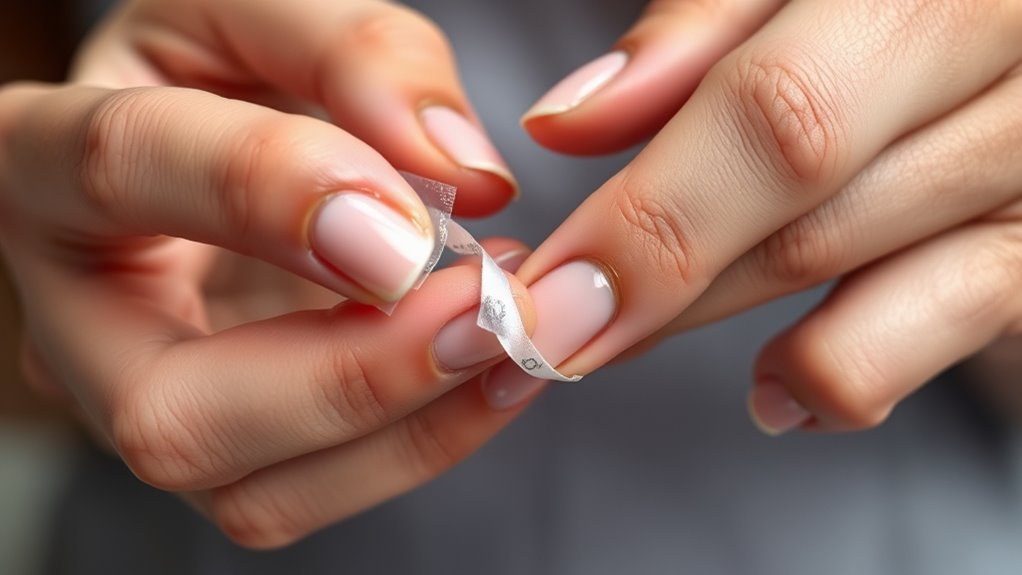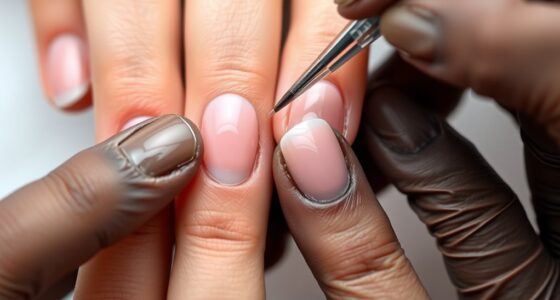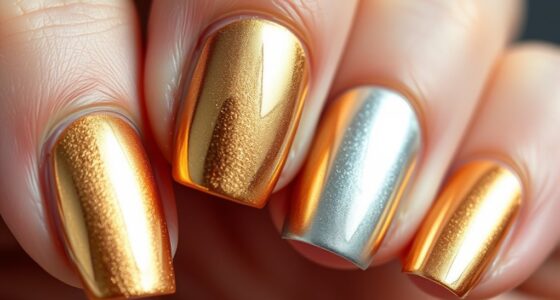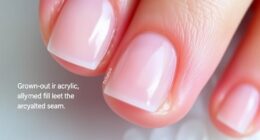To prevent flooded cuticles during polish, start by prepping your nails and cuticles—clean, push back, and apply nourishing oils. Use fine brushes and steady strokes for precise, thin coats, and apply a barrier base coat to protect your skin. Keep your hand steady, work slowly, and immediately clean any excess with a fine brush. Patience during drying guarantees a flawless finish. If you want to perfect this skill, there’s more to discover below.
Key Takeaways
- Properly push back and hydrate cuticles before applying polish to create a clean, protected nail edge.
- Use a barrier base coat to shield cuticles from excess polish and prevent flooding.
- Apply polish with fine brushes and controlled, thin coats for precision and reduced overflow.
- Employ nail tape along cuticle lines to serve as a barrier against flooding during application.
- Allow each layer to fully dry before adding the next, minimizing the risk of smudging and flooding.
Prepare Your Nails and Cuticles Before Applying Polish
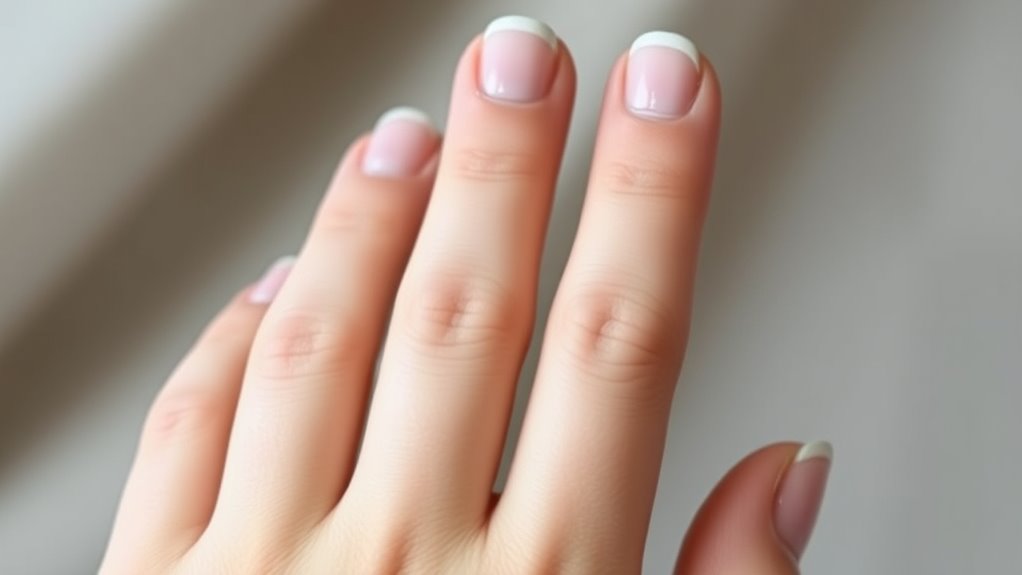
Before you apply polish, it’s essential to prepare your nails and cuticles properly. Good nail health starts with clean, smooth nails free of oils and residues that can interfere with polish adhesion. Gently push back your cuticles with a cuticle pusher to prevent them from overlapping onto your nail plate. This cuticle care step helps create a clean surface, reducing the risk of flooded cuticles during application. Use a nourishing cuticle oil regularly to keep your cuticles soft and healthy, making them less prone to damage or tearing. Properly prepped nails not only promote better polish adherence but also improve nail health overall. Additionally, cuticle health plays a significant role in preventing issues like flooding or uneven polish application. Consistent maintenance and cleaning of your nails and tools ensures a hygienic process and helps prevent infections. Regularly inspecting your tools for damage and replacing them when necessary can also help maintain optimal nail health and prevent complications. Incorporating proper cleaning techniques for your tools can further reduce the risk of contamination and ensure a safer, more effective manicure process. Taking these small steps ensures a more professional-looking finish and minimizes issues like flooding or uneven polish application.
Use the Right Tools for Precise Polish Application
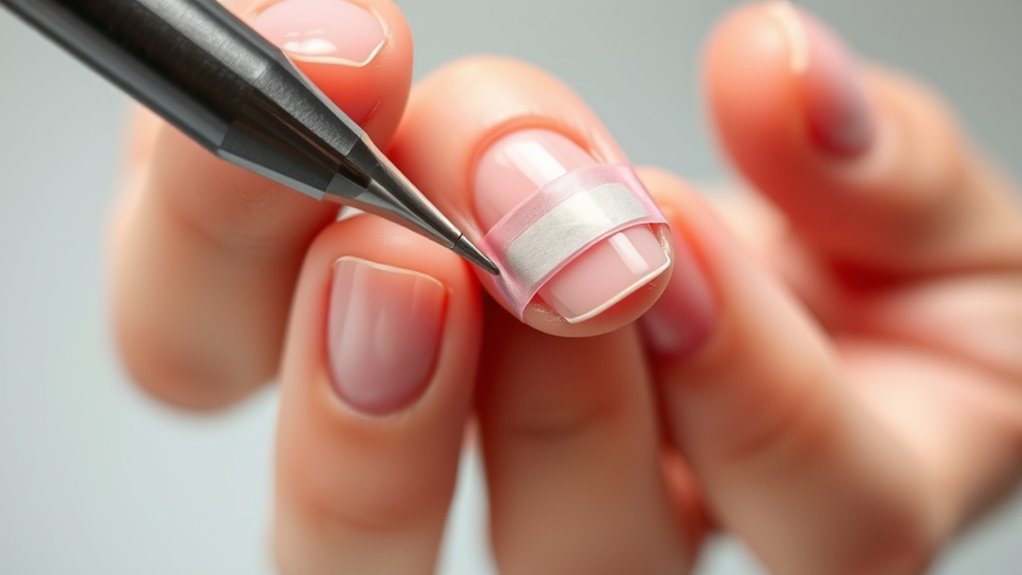
Using the right tools can make all the difference in achieving clean, precise polish. Fine-tipped brushes help you target small areas, while nail tape keeps edges sharp and tidy. Don’t forget to start with a quality base coat to guarantee smooth application and better control. Proper technique is also essential for preventing flooding and ensuring a flawless finish. Additionally, understanding industry trends can help you select the most effective tools for your manicure style. Selecting the appropriate paint sprayer models can further enhance your precision and efficiency during detailed work, ensuring a professional-looking result. Regularly updating your knowledge on skincare ingredients like glycolic acid can also contribute to healthier nails and cuticles, preventing issues such as flooding and damage.
Choose Fine-Tipped Brushes
To achieve clean, neat edges and prevent flooded cuticles, choosing fine-tipped brushes is essential. Your brush selection plays a vital role in applying polish precisely where you want it. Fine-tipped brushes are precision tools that allow you to control the amount of polish and target specific areas without spilling over. They help you create sharp, clean lines, making it easier to keep polish off your cuticles. When selecting brushes, opt for those with thin, tapered bristles designed for detailed work. Using the right tools minimizes mess and gives you greater control, ensuring your manicure looks professional. Proper brush choice can also help mimic professional painting techniques, leading to a more polished finish. Additionally, maintaining your brushes in good condition ensures optimal performance and longevity. Choosing brushes with high-quality bristles can improve polish application and reduce fraying over time. Incorporating specialized manicure tools can further enhance precision and prevent mishaps during application. With the right brush selection, you’ll find it easier to prevent flooded cuticles and achieve a flawless finish.
Use Nail Tape for Edges
Nail tape is an essential tool for achieving sharp, clean edges when applying polish, especially if you want to prevent flooding your cuticles. Using nail tape provides effective edge protection, allowing you to create precise lines without mess. Simply place the tape carefully along your cuticle line, ensuring it adheres firmly to prevent any polish bleed. When you paint your nails, the tape acts as a barrier, catching any excess polish and keeping it away from your skin. Once your polish is dry, gently peel off the tape to reveal crisp, perfect edges. This technique minimizes the risk of flooding your cuticles, saves cleanup time, and results in a professional-looking finish. Nail tape truly is a cost-effective game-changer for achieving flawless, neat borders every time. Proper application techniques help ensure the tape stays in place and prevents smudging or uneven edges. Additionally, using the correct type of adhesive can improve tape adherence and make removal easier without damaging the polish.
Select Quality Base Coats
Choosing a high-quality base coat is essential for achieving a smooth, long-lasting manicure and preventing flooded cuticles. When selecting your base coat, look for formulas designed for durability, as selecting long-lasting formulas helps your polish stay intact and reduces touch-ups. Experimenting with different textures, like gel or rubberized bases, can improve adhesion and create a better foundation for your polish. A good base coat also fills in ridges and smooths out the nail surface, making it easier to apply polish precisely without flooding the cuticles. Always apply a thin, even layer, and let it dry thoroughly before moving on. Ensuring proper application timing can help your base coat set effectively and prevent issues like flooding. Investing in quality base coats ensures a cleaner application and helps you avoid the mess and frustration of flooded cuticles. Additionally, integrating AI security measures in your nail care routine, such as digital appointment systems or online tutorials, can enhance your overall experience and protect your personal information. Proper nail preparation techniques, including cleaning and buffing, also contribute to a smoother application and better adhesion.
Apply a Barrier Base Coat to Protect Your Skin
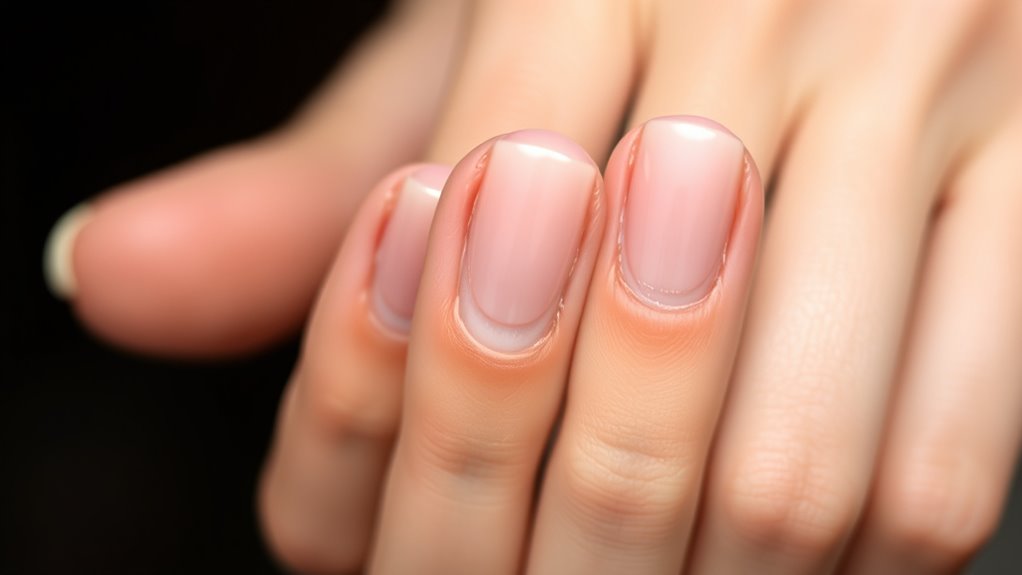
Applying a barrier base coat creates a protective layer that shields your cuticles from excess moisture and damage. This step is essential for maintaining nail health and preventing flooded cuticles during polish application. A good barrier coat acts as a barrier against liquids and pigments, reducing the risk of staining or over-saturation that can lead to peeling or lifting. It also helps preserve cuticle hydration, preventing dryness that can cause cracking or irritation. By creating a sturdy shield, you ensure your skin stays protected while allowing your polish to adhere smoothly. Additionally, choosing products from trusted brands like Patchology can ensure you are using quality ingredients that support skin health. Using a barrier base coat can also extend the longevity of your manicure by preventing polish lifting and chipping. Remember, using a barrier base coat is a simple yet effective way to keep your nails looking fresh and healthy, reducing the chances of flooded cuticles and ensuring a flawless finish.
Master the Technique of Thin, Even Coats
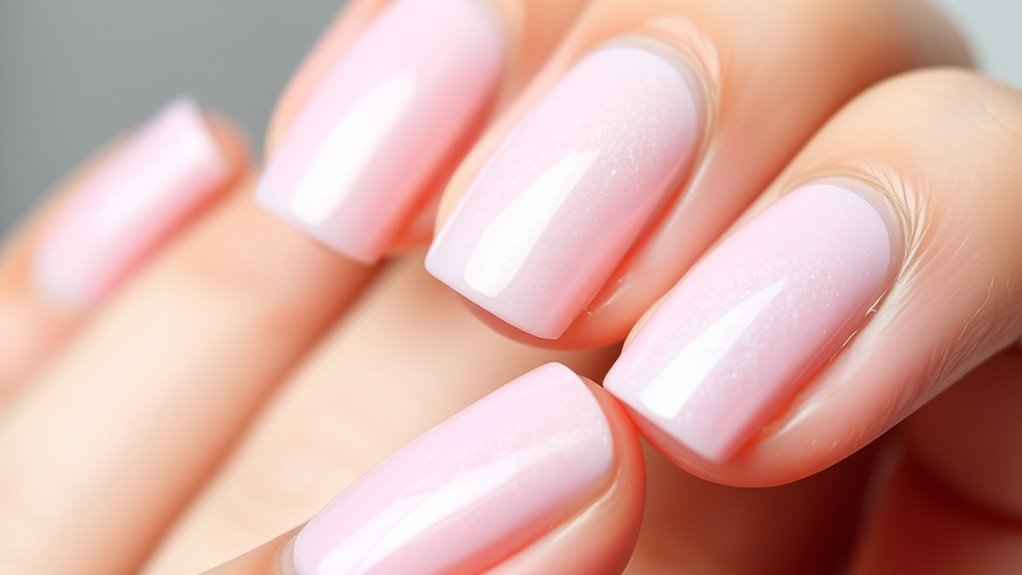
To achieve a smooth, professional-looking manicure, mastering the technique of thin, even coats is essential; it helps your polish dry faster, reduces smudges, and prevents uneven buildup that can cause chipping. Focus on brush techniques that control the amount of polish you pick up—less is more. Keep your polish consistency smooth and free of lumps for easy application. Use the tip of your brush to spread a thin layer from the cuticle to the tip, avoiding excess at the edges. Work in light, controlled strokes to ensure the coats stay even and precise. Applying multiple thin coats instead of one thick layer will give you a flawless finish and help prevent flooded cuticles. Remember that proper application techniques are crucial for achieving a professional look and avoiding common mistakes. Practice patience and consistency for the best results.
Keep a Steady Hand and Use Controlled Strokes
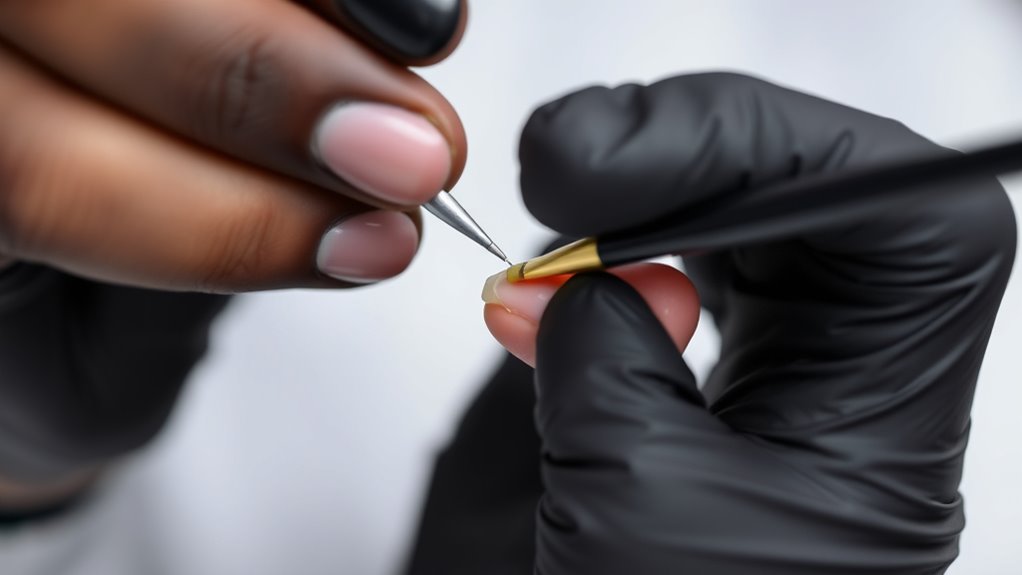
To prevent flooding your cuticles, keep a steady hand and focus on controlled brush strokes. Using precise movements helps you apply polish smoothly and minimizes excess. With consistent technique, you’ll achieve a clean, professional look every time.
Steady Hand Techniques
Maintaining a steady hand is essential for preventing flooded cuticles during nail application. Your brush control and hand steadiness determine how precisely you apply polish, avoiding messy overlaps. To improve, focus on these techniques:
- Keep your hand relaxed to reduce tremors.
- Use small, controlled strokes instead of rushing.
- Rest your hand on a stable surface for added stability.
- Practice slow, deliberate movements to build confidence.
These habits help you develop a smooth, confident application style. When your hand remains steady, your brush control improves, making it easier to avoid flooding cuticles. Consistent practice enhances your precision, ensuring a cleaner, more professional finish. Remember, a steady hand isn’t just about skill—it’s about patience and mindful movement. With these techniques, you’ll master the art of flawless polish application.
Controlled Brush Movements
Keeping your brush movements controlled is key to preventing flooded cuticles during nail application. When you focus on brush control and stroke precision, you’ll achieve cleaner, more professional results. Use small, deliberate strokes, avoiding hurried motions that can cause excess polish to seep onto the skin. Maintain a steady hand, and don’t rush the process—precision matters. To help visualize the importance, consider this emotional table:
| Confidence | Frustration | Satisfaction |
|---|---|---|
| Steady strokes build trust in your skill. | Wobbly movements lead to messes. | Clean edges boost pride. |
| Consistent control creates beauty. | Flooded cuticles cause stress. | A flawless finish feels rewarding. |
| Practice makes perfect. | Mistakes feel discouraging. | Success feels empowering. |
| Calm hands produce precision. | Anxiety ruins control. | Achieving neat nails feels amazing. |
Mastering controlled brush movements transforms your manicure experience and results.
Minimize Excess Polish
A steady hand and controlled strokes are essential for minimizing excess polish and preventing floodings. When you apply polish with care, you reduce the risk of spilling onto your cuticles, making cleanup easier. Focus on gentle removal of excess polish along the edges, ensuring your cuticle care remains intact. Keep your hand steady, and use small, deliberate strokes to maintain precision. This approach not only prevents flooding but also creates a clean, professional look.
Remember:
- Use minimal pressure for smooth application
- Stop before reaching the cuticle line
- Wipe excess polish with a brush or brush cleaner
- Prioritize gentle removal of polish around cuticles
Practicing these techniques helps you achieve neat, flawless nails, free of flooded cuticles.
Clean up Excess Polish Immediately With a Fine Brush
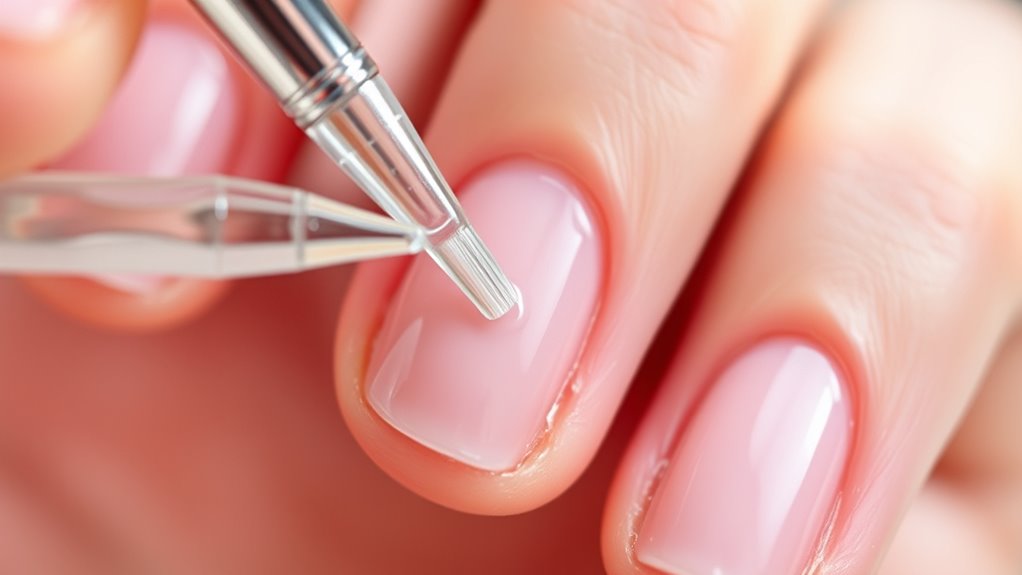
As soon as you notice excess polish around your cuticles, grab a fine brush to clean it up immediately. Dip the brush in polish remover or a bit of cuticle oil to gently wipe away stray polish. Doing this quickly prevents the polish from drying and spreading, saving you from flooded cuticles later. Keep a small dish of remover handy for quick touch-ups. Here’s a helpful guide:
| Tip | Benefit |
|---|---|
| Use a fine brush | Precise cleanup around cuticles |
| Dip in polish remover | Easily removes dried polish |
| Apply cuticle oil afterward | Keeps cuticles moisturized |
| Clean immediately | Prevents flooding & smudges |
| Work gently | Avoids damaging the polish |
Staying proactive ensures a neat finish every time.
Practice Patience and Allow Each Layer to Dry Properly
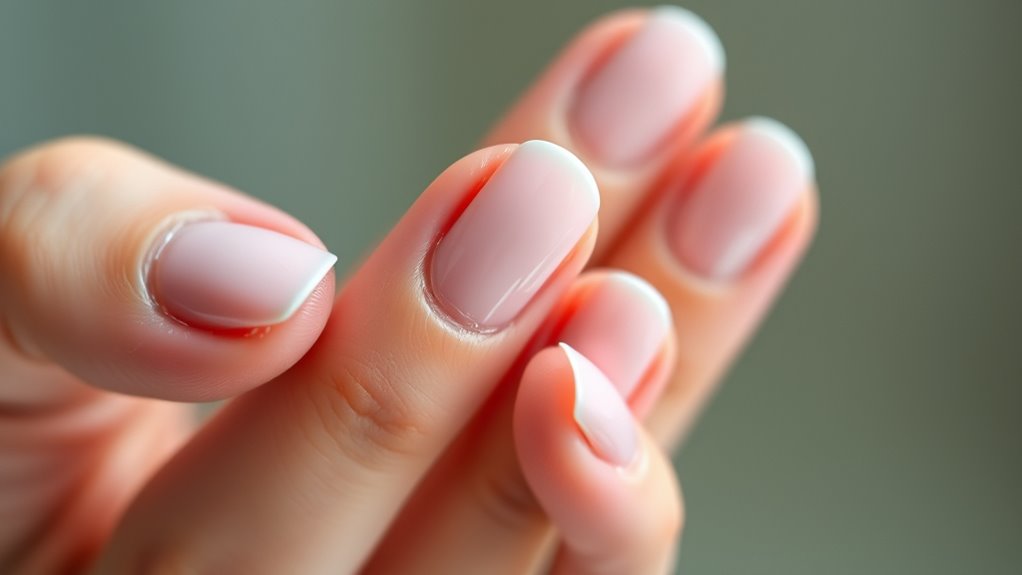
Rushing through each nail layer can easily lead to smudges, uneven finishes, or flooded cuticles. Patience practice is essential to achieve a flawless look. Allow each coat to dry completely using proper drying techniques—whether air drying or using a gentle fan. Skipping this step risks ruining your polish and creating messes.
Remember, patience pays off. Here’s what you can do:
- Take your time between layers to prevent smudges
- Use a quick-dry spray or fan to speed up drying
- Avoid touching or bumping nails prematurely
- Trust the process for a long-lasting, professional finish
Mastering patience practice and drying techniques ensures your polish dries smoothly, with no flooded cuticles, giving you stunning results every time.
Frequently Asked Questions
How Do I Prevent Polish From Flooding My Cuticles During Application?
When applying polish, you want to keep your cuticles healthy and your nails well-hydrated. To prevent floodng cuticles, use a thin brush or a small amount of polish and stay close to the nail edge without touching the cuticles. Be mindful of excess polish, and clean up any spills quickly. Proper cuticle care and nail hydration help maintain overall nail health and make polish application neater and longer-lasting.
What Are the Best Drying Techniques to Avoid Cuticle Flooding?
Imagine your nails as tiny canvases, waiting for a perfect stroke. To avoid cuticle flooding, use precise brush techniques that control polish flow, and verify your polish consistency isn’t too runny. When drying, hold your nails in a gentle fan or use a cool setting on your dryer to prevent smudges and flooding. This mindful approach lets your manicure dry flawlessly, showcasing clean edges and smooth, beautiful nails.
Can Cuticle Oils Help Prevent Flooded Cuticles?
Cuticle oils can definitely help improve cuticle health and nail hydration, making your cuticles less prone to flooding. When you regularly apply nourishing oils, they create a barrier that keeps moisture in and prevents excessive buildup during polishing. This not only maintains healthy, hydrated cuticles but also enhances overall nail appearance. So, incorporating cuticle oils into your nail care routine is a smart move for preventing flooded cuticles and promoting strong, beautiful nails.
Are There Specific Polish Formulas That Reduce Flooding Risk?
You should look for gel formulas and quick dry polishes that are designed to minimize flooding. These formulas typically have a thicker consistency or controlled brush application, helping you avoid excess product spilling over your cuticles. Quick dry polishes also reduce the risk because they dry faster, giving you more control. By choosing these types of polishes, you make it easier to keep your cuticles neat and prevent flooding.
How Does Nail Shape Affect the Likelihood of Flooded Cuticles?
Your nail shape influences flooding risk because certain shapes, like rounded or almond, leave less space for excess polish to spill onto cuticles during application. By choosing a nail shape that minimizes gaps, you enhance cuticle protection and make polish application neater. Understanding how nail shape impacts flooding helps you control excess polish, reducing the chance of flooded cuticles and ensuring a cleaner, more professional-looking finish with less effort.
Conclusion
Remember, a little patience goes a long way—”Haste makes waste.” By preparing your nails, using the right tools, and applying thin, controlled coats, you can prevent flooded cuticles and achieve flawless polish. Take your time with each step, and don’t rush the drying process. With practice, perfect nails will become second nature. Keep this in mind, and you’ll enjoy beautiful, professional-looking results every time.
